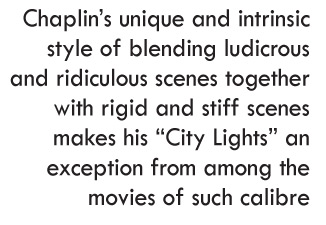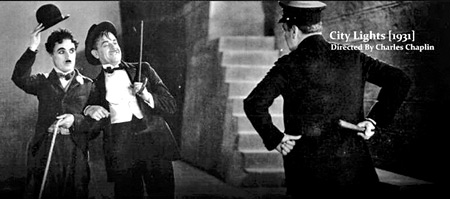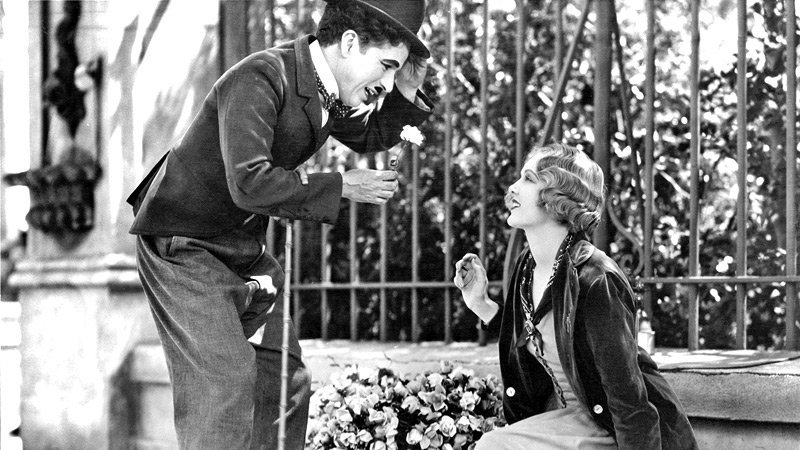Even nearly 48 years after the death of Sir Charlie Chaplin, the pivotal contributions that Chaplin had made to develop the art of silent films can neither be compared nor be replaced.
 Starting his acting career as young as eight years, even almost five decades after his death, his popularity has never dwindled but ever grown and Chaplin was still considered as an innovator in the ever demanding, expensive and flourishing business of filmmaking.
Starting his acting career as young as eight years, even almost five decades after his death, his popularity has never dwindled but ever grown and Chaplin was still considered as an innovator in the ever demanding, expensive and flourishing business of filmmaking.
 “City Lights”, unveiled by United Artists is Chaplin’s most relished and cherished film. Chaplin himself wrote the film’s script whilst simultaneously being its director and the producer. “City Lights” is also said to be his terminal and paramount ‘Little Tramp’ chronicle.
“City Lights”, unveiled by United Artists is Chaplin’s most relished and cherished film. Chaplin himself wrote the film’s script whilst simultaneously being its director and the producer. “City Lights” is also said to be his terminal and paramount ‘Little Tramp’ chronicle.
Chaplin brought off an extraordinary level of poise and grace in terms of physical comedy and dramatic pathos along with this particular silent anecdote of a charming and darling drifter falling for a young blind woman who earns her living by selling flowers at the wayside and mistakes the Tramp for a plutocrat.
“City Lights” is one of the most talked about American silent romantic comedies that was released in 1931: it is also considered as its director Chaplin’s crowning achievement in cinema. The movie presents a moving story where the Tramp, its protagonist, played by Chaplin himself falls in love with a poor blind girl, played by Virginia Cherrill; the blind girl is just convinced that the Tramp is a man born with a silver spoon.
Any viewer would find it to be an effortlessly tender, absorbing, and intriguing movie that has an abundance of integrity and hopes in which love frankly dares to spread its wings. Chaplin together with his cast have remarkably crafted a silent movie which is enriched with an affluence of excessively and exceedingly rich shots of which identity still remains unshattered. Some critics call it “The Labor of Love” while the latter part of the film is acute and severe.
The fidelity and trueness that the Tramp has towards the blind girl give rise for him to take up with a slew of lowly unskilled jobs in order to earn money that can play the role of a polished and refined man. The power of sight is the central theme of “City Lights” which elevated Chaplin into the brilliance of cinematic genius. A fine blend of humour and humanity is a noticeable element that makes “City Lights” memorable among the moviegoers.
An eye-opener
 Chaplin had been slightly influenced by the tradition involved in the old-fashioned silent movies, critics find that the film is enriched with a timeless significance and value. The film was technically a crossover notably due to the fact that the soundtracks of the film were included with synchronised music and sound effects where no spoken language was available. The 1931 film is an eye opener that speaks as to how the society appreciates the petty and paltry aspects of people over the deeper person by means of blindness.
Chaplin had been slightly influenced by the tradition involved in the old-fashioned silent movies, critics find that the film is enriched with a timeless significance and value. The film was technically a crossover notably due to the fact that the soundtracks of the film were included with synchronised music and sound effects where no spoken language was available. The 1931 film is an eye opener that speaks as to how the society appreciates the petty and paltry aspects of people over the deeper person by means of blindness.
Chaplin successfully mixed nonchalant and blithe comedy with profound and compounded ideas on the issues in society. Chaplin’s use of gags, music and sincere love connections in numerous ways would clearly paint and depict the relevant point of the film. Chaplin’s unique and intrinsic style of blending ludicrous and ridiculous scenes together with rigid and stiff scenes makes his “City Lights” an exception from among the movies of such calibre.
He put together a masterpiece which came to a crescendo ultimately with the blind girl seeing with her own eyes the man who she fell in love with; it could also be noted as a significant moment where Chaplin hits in the face of the viewer along with the comprehension and awareness that the precedence in the society is unfounded where the prominent things are not able to be seen through the eye.
Waddling along with his cane, wearing his Derby hat whilst decorating his face with a tiny moustache, the Little Tramp of the “City Lights” is arguably different from any other character in the domain of films. Chaplin has done an incredibly phenomenal job within his role of the Little Tramp; the romantic relationship that he develops towards the blind girl is flawlessly convincing. his concern on treating himself slightly more consequential and earnest in “City Lights” has brought out spectacular consequences. “City Lights” is known to be the most difficult endeavour that Chaplin ever undertook in his career.
It is reported that Chaplin had taken two years and eight months for the successful completion of the film where actual shooting had taken around 190 days. It is also astounding to note that Chaplin had relied on Virginia Cherill, a 20-year-old Chicago socialite and recent divorcee to play the role of the blind girl, despite Cherill being still an amateur and “City Lights” was her debut.









